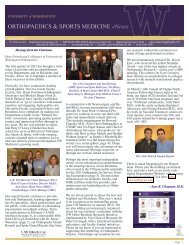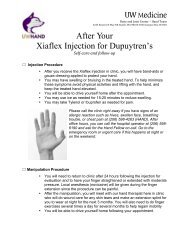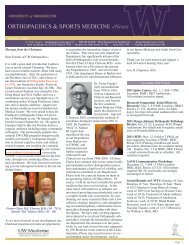Ream and Run for Shoulder Arthritis: Conservative Reconstructive ...
Ream and Run for Shoulder Arthritis: Conservative Reconstructive ...
Ream and Run for Shoulder Arthritis: Conservative Reconstructive ...
You also want an ePaper? Increase the reach of your titles
YUMPU automatically turns print PDFs into web optimized ePapers that Google loves.
<strong>Shoulder</strong> & Elbow Service, University of Washington Department of Orthopaedics <strong>and</strong> Sports Medicine<br />
The arthritic surface of the ball is replaced<br />
with a metal ball with a stem that is press fit<br />
down the inside of the arm bone (humerus) so<br />
that only the smooth surface extends from the<br />
bone.<br />
This procedure is per<strong>for</strong>med through an incision<br />
between the deltoid <strong>and</strong> the pectoralis<br />
major muscles on the front of the shoulder. It<br />
includes release of adhesions <strong>and</strong> contractures<br />
<strong>and</strong> removal of bone spurs that may limit<br />
range of motion. Our team of experienced<br />
surgeons, anesthesiologists, <strong>and</strong> surgical assistants<br />
usually per<strong>for</strong>m this procedure in less<br />
than two hours.<br />
How Is The Humeral Component Fixed<br />
In The Humerus?<br />
While some surgeons cement the humeral component<br />
<strong>and</strong> others use implants that foster bone ingrowth,<br />
we find that these approaches (a) stiffen the<br />
bone making it more likely to fracture in a fall <strong>and</strong><br />
(b) greatly complicate any revision surgery that may<br />
become necessary in the future. We prefer to fix the<br />
component by impaction grafting the inside of the humerus<br />
(using bone harvested from the humeral head<br />
that has been removed) until a tight press fit of the<br />
implant is achieved.<br />
What Happens To The Raw Bone Surface Left<br />
After The <strong>Ream</strong>ing Of The Glenoid?<br />
Laboratory studies at the University of Washington<br />
have shown that the reamed socket (glenoid) can<br />
heal over with a smooth fibrocartilagenous surface.<br />
The illustrations to the right show the socket surface<br />
just after reaming <strong>and</strong> six months later.















